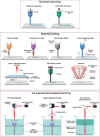Toward better drug development: Three-dimensional bioprinting in toxicological research
- PMID: 37065668
- PMCID: PMC10090537
- DOI: 10.18063/ijb.v9i2.663
Toward better drug development: Three-dimensional bioprinting in toxicological research
Abstract
The importance of three-dimensional (3D) models in pharmacological tests and personalized therapies is significant. These models allow us to gain insight into the cell response during drug absorption, distribution, metabolism, and elimination in an organ-like system and are suitable for toxicological testing. In personalized and regenerative medicine, the precise characterization of artificial tissues or drug metabolism processes is more than crucial to gain the safest and the most effective treatment for the patients. Using these 3D cell cultures derived directly from patient, such as spheroids, organoids, and bioprinted structures, allows for testing drugs before administration to the patient. These methods allow us to select the most appropriate drug for the patient. Moreover, they provide chance for better recovery of patients, since time is not wasted during therapy switching. These models could be used in applied and basic research as well, because their response to treatments is quite similar to that of the native tissue. Furthermore, they may replace animal models in the future because these methods are cheaper and can avoid interspecies differences. This review puts a spotlight on this dynamically evolving area and its application in toxicological testing.
Keywords: ADME test; Drug development; Liver; Organoid; Spheroid; Three-dimensional printing.
Copyright: © 2023 Author(s).
Conflict of interest statement
The authors declare no conflict of interest.
Figures






References
-
- Li AP. Screening for human ADME/Tox drug properties in drug discovery. Drug Discov Today. 2001;6:357–366. https://doi.org/10.1016/s1359-6446(01)01712-3. - PubMed
-
- Wishart DS. Emerging applications of metabolomics in drug discovery and precision medicine. Nat Rev Drug Discov. 2016;15:473–484. https://doi.org/10.1038/nrd.2016.32. - PubMed
-
- Hingorani AD, Kuan V, Finan C, et al. Improving the odds of drug development success through human genomics:Modelling study. Sci Rep. 2019;9:18911. https://doi.org/10.1038/s41598-019-54849-w. - PMC - PubMed
-
- Serras AS, Rodrigues JS, Cipriano M, et al. A critical perspective on 3D liver models for drug metabolism and toxicology studies. Front Cell Dev Biol. 2021;9:626805. https://doi.org/10.3389/fcell.2021.626805. - PMC - PubMed
-
- Park Y, Huh KM, Kang SW. Applications of biomaterials in 3D cell culture and contributions of 3D cell culture to drug development and basic biomedical research. Int J Mol Sci. 2021;22:2491. https://doi.org/10.3390/ijms22052491. - PMC - PubMed
Publication types
LinkOut - more resources
Full Text Sources
